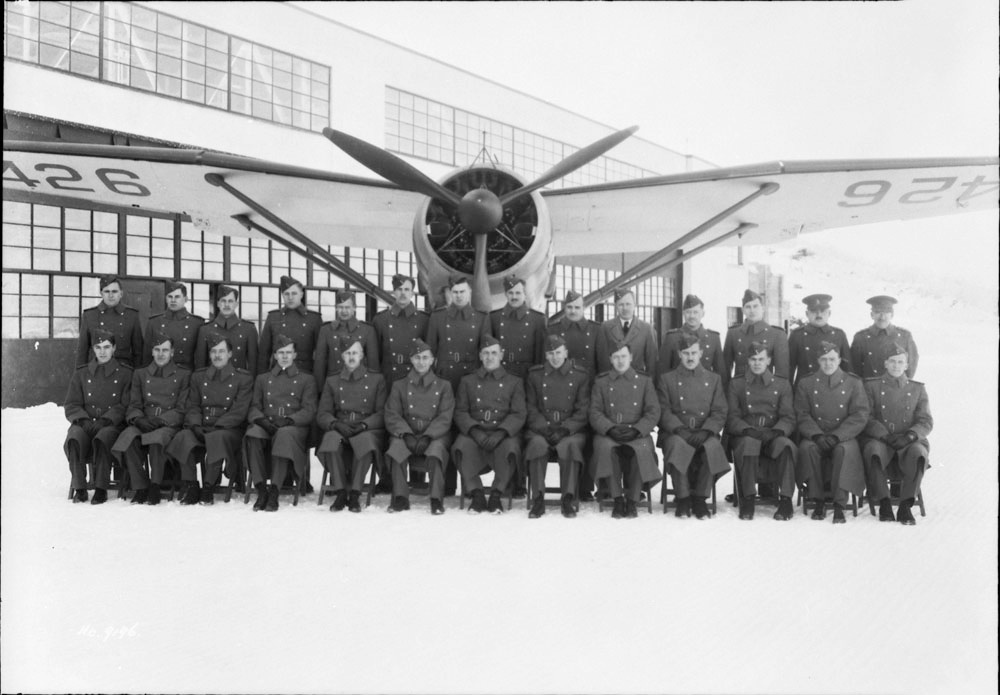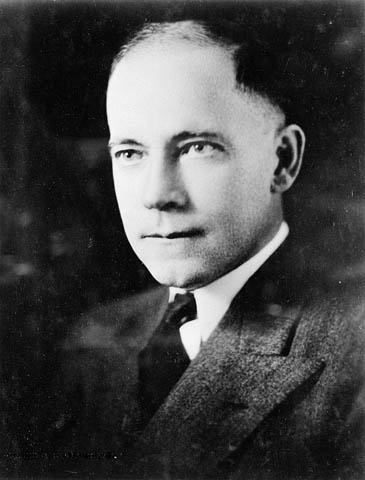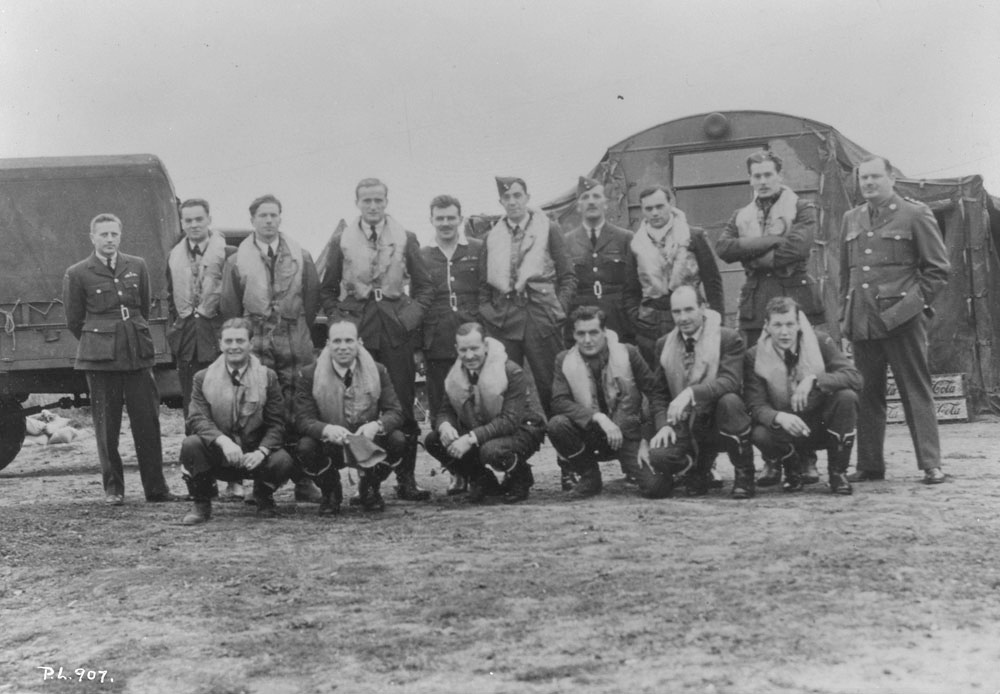In this post I will attempt to lay out the background to and eventual deployment of Canadian airmen during the Battle of Britain. Most of this post talks about the first Canadians sent to England as part of the RCAF contingent. While there were many Canadian volunteers within the RAF itself, this post is about the RCAF specifically.
Sources:
“The Crucible of War: 1939-1945, The Official History of the Royal Canadian Air Force Volume III” Written by Brereton Greenhous, Stephen J. Harris, William C. Johnston, and William G.P. Rawling. ISBN 0-8020-0574-8
“Reader’s Digest: The Canadians at War: Volumes 1 & 2” ISBN-10 0888501617 (A compilation of articles ranging from personal stories to overviews of Canadian involvement in a particular campaign. Contains excerpts from a number of more obscure Canadian books written after the war, published 1969)
If any of you have read my Air Power over the Atlantic series, you will know from reading my RCAF post that the Canadian Air Force was not in a strong situation at the start of the war. The officer corp was small, many aircraft were outdated and many squadrons were understrength. A more complete understanding of their situation can be found there.
According to “The Crucible of War: 1939-1945”, an official history of the RCAF,
"…When Great Britain declared war on the 3rd of September 1939, Fighter Command had only thirty-nine squadrons in hand, however, and four of those, equipped with Hurricanes, were promptly dispatched to France as part of the Advanced Air Striking Force (AASF). Two more would be added later. Meanwhile, the Air Ministry took advantage of the ‘Phoney War’ to set about organizing eighteen additional squadrons.
One of the eighteen was No. 242 (Canadian) Squadron, RAF. Formed at Church Fenton in Yorkshire, it was the result of a public-relations exercise benefiting both the Canadian and British governments. On the 12th of September 1939, six days after British Prime Minister Neville Chamberlain made initial proposals for what would become the BCATP, and just two days after the Canadian declaration of war, Prime Minister Mackenzie King (requiring a public display of Canadian involvement that would not cost as many lives as a large army contingent) quickly declared, ‘It is the desire of this Government that Canadian Air Force units be formed as soon as sufficient trained personnel are available overseas for this purpose.’
The British, equally interested in displaying the solidarity of empire and commonwealth, were also keen to see and RCAF unit in the field. They first suggested that an RCAF maritime squadron reconnaissance squadron be based in the Caribbean, but a lack of suitable aircraft thwarted that proposal. Moreover, with negotiations for the BCATP now underway, an option that the Canadian government found far more politically favorable, some were having second thoughts about overseas commitments. O.D. Skelton, undersecretary of state for external affairs and one of King’s closest associates, explained to the British high commissioner in Ottawa:
“Whilst it is for many reasons desirable that Canada’s contribution to the air war should be recognized and confirmed by the early participation of RCAF units overseas, it must be borne in mind that the immediate despatch of even one unit would seriously detract from the inception and development of the scheme for training in Canada.” Sending an RCAF squadron overseas, therefore, ‘should not now be contemplated.’
The Air Ministry put forward an alternate idea: something might be done with the Canadian airmen already in the RAF or serving with it as RCAF exchange officers. By the end of October 1939 arrangements were complete for the formation of a fighter squadron with Canadian aircrew, providing Mackenzie King with a ‘much to be desired recognition if Canadian participation’ at virtually no cost to his government in people, machines, or dollars. An RCAF officer already in England, Squadron Leader F.M. Gobeil, a highly-anglicized, French-Canadian graduate of the Royal Military College, was placed in command.
Since all, or nearly all, of the squadron’s non-flying personnel were British, and only the commanding officer was RCAF, the record of its training in England and its misfortunes during the Battle of France lie outside the bounds of this volume…"
Any of you who are interested can read my post “Introduction to No. 242 Squadron” which does give some background to No.242. What is known is that of the 22 pilots on strength on the 10th of May, seven were killed in action, three captured, three wounded. Replacements, for the most part British, had begun arriving in late May and early June, and when the legendary Squadron Leader Douglas Bader took over command from Gobeil on the 24th of June, No 242’s last link with anything formally Canadian was cut. Eventually sent to the Far East in December 1941 (to be annihilated in the Dutch East Indies by early March 1942), it was then just another RAF unit with perhaps less than the usual proportion of Canadians to be found in British Squadrons.
I may eventually discuss No.242 Squadrons exploits during the Battle of Britain in another post.
The History of the Royal Canadian Air Force discusses the differences between RCAF and RAF doctrine as follows; The British War Office had an obsolete understanding of how air power should be applied. The British Army sought nothing less than self-contained air forces under military control - an air ‘brigade’ for each field army, similar to the arrangements that had prevailed in 1917 and 1918, while the Air Ministry insisted on the benefits of centralized control, citing enhanced flexibility and economy of force when employing finite air resources and arguing that the air arm should not be subordinate to ground commanders. Quoting The History of the RCAF: Volume III…
“In the eyes of the air staff, there were other threats to be faced and conquered besides those posed by the Luftwaffe. Much of the German success on the ground, in Poland, Norway, and France, had been due to the tactical and operational integration practised by their air and ground forces. The whole concept of which was anathema RAF, who considered ground-air cooperation the lowest of their priorities. Its existence as a separate, independent, war-winning service rested on the argument that the strategic bomber was the war-winning weapon, and only reluctantly had some of the senior staff admitted that there was a role for the air superiority fighter. With no little regret they had always accepted that the army was entitled to a minimal degree of what was known as the “army cooperation”, mostly reconnaissance and artillery spotting as had been the standard in the Great War…”
In my personal opinion, neither was truly correct in the long term. The air force required independence as a separate service, not a subsidiary of the army. The War Office’s views were outdated. On the other hand, it appears that many in the RAF had pushed much too far in the other direction, insulating the RAF from the other services and focusing solely on the strategic bomber as a war-winning weapon.
Canadian airmen, in contrast to the RAF, were much more amenable to army cooperation, possibly because Canadian airmen had been largely ‘bush pilots in uniform’ during the interwar years; perhaps because the RCAF had only become an independent service in 1938; and certainly because Canada’s dominant military mind between the wars was that of soldier-scientist A.G.L. McNaughton, a dedicated advocate of air power in the land battle. In fact, while pre-war British establishments called for one army cooperation squadron per infantry corps (and one per armoured division), the RCAF was thinking in terms of a three-squadron army cooperation wing ‘for despatch overseas if required.’ When the first squadron went to Britain in early 1940 however, it inevitably became embroiled in all the troubles which frustrated it’s RAF peers, in addition to the problems those problems inherent in the broader picture of Anglo-Canadian cooperation.

(Canadian Officers of 110 posed in front of one of their Lysanders.)
On the 24th of November 1939, in London, Air Commodore L.S. Breadner had met with Sir Kingsley Wood, the British secretary of state for air, Canadian high commissioner Vincent Massey, and Wing Commander Vernon Heakes, the RCAF’s liaison officer with the RAF, to consider what air units the RCAF should provide in support of the Canadian component to the BEF, either of one division, or, later perhaps, a two division corps. Wood told the Canadians that the Air Ministry would be pleased if an army cooperation squadron arrived in the United Kingdom with the 1st Canadian Division that was expected at the turn of year (and arrived on schedule as per my Canadian Corps Overseas topic posts). It was the plan that the army division and air squadron would contribute to the BEF in France together. The Canadians would be attached to the British IV Corps, and the RCAF aircraft attached to the attendant RAF cooperation squadron for said corps.
No 110 Squadron, RCAF, flying Westland Lysanders, was selected and placed under the command of Squadron Leader W.D. Van Vliet, who was a graduate of both the RAF Staff College and the RAF’s School of Army Cooperation, where he had finished first in his class. His Staff College instructors found him ’ an honest, great-hearted and cheerful personality…His sincerity and honesty of purpose are marked.’ His unit was an amalgam of Permanent Force and Auxiliary airmen. Its core was No 110 (City of Toronto) Squadron, reinforced by Permanent Force personnel from No 2 (Army Cooperation) Squadron and supplemented by Auxiliaries from Winnipeg, Calgary, and Regina. The squadron arrived in England in late February 1940, still largely untrained, ostensibly to work with the 1st Division until both reached BEF standards. It was, however, condemned to thrash about in a political and bureaucratic wasteland for many months to come, a struggle that would frequently frustrate everyone concerned, most of all Van Vliet. At the vortex of events, he was compelled to juggle demands, requests, and suggestions from a quite unreasonable number of superiors while trying to maintain the morale of his subordinates in an extraordinarily difficult environment.
As an RCAF unit, No 110 Squadron was subject to the newly-formed Overseas HQ in London, while as an army cooperation squadron it was part of the RAF’s No 22 Group, responsible for army cooperation training. Major-General McNaughton, senior Canadian military officer overseas, considered that it came under his operational command, even if its administration and supply were RAF/RCAF responsibilities, while he himself was functionally subordinate to the War Office in London, but, at the same time, had an overriding political tie to the Canadian government in Ottawa.

(Westland ‘Lysander’ aircraft of No.110(AC) Squadron, R.C.A.F. January 30th, 1940)
To make an awkward situation worse, there was no provision in British (or Canadian) war establishments for an army cooperation squadron to be allocated to a single infantry division. As noted, British doctrine called for one squadron per infantry corps, of two or three divisions; but McNaughton crustily proclaimed his ‘understanding that 110 (AC) Squadron, RCAF, has been provided primarily for the purpose of working with the Canadian forces in the field, and I hope that there will be no doubt that our requirements in this connection will have priority.’ Thus, at least until the 2nd Division arrived and a Canadian Corps organization could be established, the squadron found itself adrift between the rock of McNaughton and the hard place of air force insularity.
An example of the complicated situation played out on the 6th of May 1940 when Norman Rogers, the minister of national defence, met with Sir Samuel Hoare (who had succeeded Kingsley Wood as secretary of state for air) to try and clarify financial relationships created by wartime circumstances. To Rogers, financing the BCATP and whatever units the RCAF sent overseas were both part of one overall arrangement. Indeed, in accepting a larger share of BCATP costs the government of Canada had reduced the number of army cooperation squadrons it had been planning to send overseas from three to one. Ottawa supplying only the pay and allowances of the personnel while Whitehall supplied equipment and maintenance. That arrangement fit very poorly with McNaughtons idea of a making the squadron an integrated part of the army forces overseas, who were completely financed from Canadian resources. Hoare pointed out the anomaly, suggesting that once a Canadian corps had been formed and the squadron was working exclusively with it, ‘it might be reasonable to suggest that it should be equipped and maintained in the same way that Canadian Troops were.’ The meeting then turned to the more immediate problem of No 110’s affiliations when the 1st Division went to France, no one foreseeing the imminent German attack that would make the discussion irrelevant.

(The Hon. Norman Rogers, Minister of Defence, March 1940.)
On their arrival in England, the squadron’s pilots and air gunners had initially been kept busy with individual and specialist training at the School of Army Co-operation near Salisbury. By June their basic training was complete and they were moved to Odiham, in Hampshire, for operational training, still flying the twelve Lysanders they had brought from Canada. Speaking of the Lysander, it is described as ’ Well designed for its time, with versatility and easy maintenance.’ It had excellent short take-off and landing capabilities, well suited to the makeshift runways one might find near the frontlines. Despite these qualities, it was obsolescent by the time of the German invasion of Poland, and practically a flying coffin by the evacuation of Dunkirk. Thankfully, the RCAF wouldn’t get the chance to prove it. They were kept in England throughout the Battle of France and the evacuation, and even throughout the Battle of Britain they remained mere bystanders, grounded for the most part to keep the skies clear for Fighter Command. This badly affected their morale, as Flight Lieutenant C. Carling-Kelly, who commanded ‘C’ Flight wrote;
‘Young healthy pilots, rarin’ to go, eating their hearts out as we watched the daily air battles from the safety of our shelters around the station. It was a bad situation and Van Vliet kept more and more to himself, confiding in no one. We all had our dreams, it was the futility of them that was beginning to erode our morale, including that of the CO.’
In due course, the departure of six pilots for fighter training prior to posting as replacements to No 1 (Fighter) Squadron, RCAF, which was by now fully involved in the conflict in the sky, only made matters worse for those who remained. Van Vliet was removed from command and repatriated to Canada, on the basis that his experience was put to better use training new pilots rather than leading them in battle. He was significantly older than most of his subordinates, and while this environment of instructor/student was useful in practice, it was not seen as effective on operations. A younger officer was given command of 110. While their bureaucratic issues were finally getting ironed out behind the scenes, morale was set to increase with the arrival of No 112 Squadron at the end of June. They had been offered nearly a month earlier, but it appears the Canadian government was waiting for ‘official approval’ before deployment. The required Lysanders were scraped up from wherever they could be found and shipped out on the 11th of June. They too trained in the skies of England, mastering obsolete aircraft and tactics until redesignated a fighter squadron and given Hurricanes in March 1941.

(The pilots of No 1 (F) Squadron RCAF)
Meanwhile, the radical transformation of the strategic situation following the fall of France led to a fundamental overhaul of Britain’s defences, and Lieutenant-General McNaughton found himself commanding VII (British) Corps, the ultimate reserve south of the Thames, consisting of his own infantry division together with a British armoured brigade and two brigades of New Zealand infantry which he quickly amalgamated into an ad hoc armoured division. His assigned corps squadron was No 110 and, for the moment, no one fussed over its technical status or its financing, all emphasis being on its tactical and technological shortcomings. Had the air battle been lost and Hitler actually committed himself to the invasion of Britain, no doubt VII Corps would have soon found itself in a desperate fight and it’s squadrons of Lysanders would have been ‘sitting ducks’ in a relentlessly hostile environment. Happily, Fall Seelowe (Operation Sealion), the proposed amphibious on assault on Britain, was cancelled on the 12th of October. There would be no landing on British shores in 1940, or (at least until the equinoctial gales were over) in the spring of 1941. On the basis of signals and photographic intelligence that the residual risk of invasion would be ‘relatively remote,’ although they were not so reckless as to broadcast their conclusions. On Christmas Day 1940 VII Corps was dissolved and the newly arrived 2nd Canadian Division joined with the 1st to form 1 (Canadian) Corps. As for No 110 Squadron, in March it became No 400, finally fitted into the regulation Anglo-Canadian military mould.
The story of the Army Coop squadrons is not a particularly exciting or epic tale, but I feel it necessary to demonstrate the bureaucratic and political mess that lay behind it all, the same way I have done with my Battle of the Atlantic topic posts. The outdated doctrine, the inter-service squabbling, the outdated and understrength nature of the RCAF at the start of the war, and the presence of (sometimes debilitating) Canadian pride, all did much more to aid the enemy than the Allied powers.